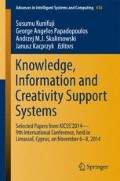Abstract
We describe a decision support system for hypothesis assessment in which exploration is supported by computational creativity. A software tool for morphological hypothesis analysis and evidence handling is extended with a creative assistant that on demand suggests hypotheses that the analyst should consider. Suggested hypotheses are chosen so that they are far from hypotheses that the analyst previously has paid attention to but nevertheless are supported by evidence in an interesting way. For the purpose of providing thought-provoking suggestions, the creative assistant employs ensembles of novelty and value assessment methods and proposes hypotheses that stand out in this multi-ensemble analysis. Preliminary experiments investigate the system’s potential for infusing novel and valid ideas into the decision making process.
Access this chapter
Tax calculation will be finalised at checkout
Purchases are for personal use only
Notes
- 1.
Note that “morphological analysis” has different meanings in decision support and linguistics. In this paper we use the term only in the former meaning.
- 2.
We suffer from a terminology collision regarding the term value between the fields of morphological analysis and computational creativity. Where the distinction is not obvious from the context a cell in the morphological chart is referred to as value cell whereas usefulness is called value charge.
References
Cole, L.A.: The Anthrax Letters. Skyhorse Publishing (2009)
Colton, S., Wiggins, G.A.: Computational Creativity: The Final Frontier? In: Proceedings 20th European Conference on Artificial Intelligence (2012)
Ehrgott, M.: Multiobjective Optimization. AI Mag. 29(4), 47–57 (2009)
Gustavi, T., Karasalo, M., Mårtenson, C.: A tool for generating, structuring, and analyzing multiple hypotheses in intelligence work. In: Intelligence and Security Informatics Conference (EISIC), pp. 23–30 (2013)
Hamming, R.W.: Error detecting and error correcting codes. Bell Syst. Tech. J. 29, 147–160 (1950)
Heuer, R.J.: Psychology of Intelligence Analysis. US Gov. Printing Office (1999)
Jändel, M.: Computational creativity in naturalistic decision-making. In: Proceedings of the Fourth International Conference on Computational Creativity, pp. 118–122 (2013)
Ritchey, T.: Wicked Problems—Social Messes: Decision Support Modelling with Morphological Analysis. Springer (2011)
Varshney, L.R.: Surprise in computational creativity and machine science. Decision Analysis Today 32, 25–28 (2013)
Wixted, J.T., Ebbesen, E.B.: Genuine power curves in forgetting: a quantitative analysis of individual subject forgetting functions. Memory Cogn. 25(5), 731–739 (1997)
Zwicky, F.: Discovery, Invention, Research Through the Morphological Approach. The Macmillan Company, Toronto (1969)
Acknowledgments
Christian Mårtensson suggested that we should consider how to apply computational creativity in morphological analysis. We thank Tove Gustavi, Maja Karasalo and Christian Mårtensson for making the MHMA tool available for our research. This research is commissioned by FMV, the Swedish Defence Materiel Administration.
Author information
Authors and Affiliations
Corresponding author
Editor information
Editors and Affiliations
Rights and permissions
Copyright information
© 2016 Springer International Publishing Switzerland
About this paper
Cite this paper
Forsgren, R., Hammar, P., Jändel, M. (2016). Computational Creativity for Intelligence Analysis. In: Kunifuji, S., Papadopoulos, G., Skulimowski, A., Kacprzyk , J. (eds) Knowledge, Information and Creativity Support Systems. Advances in Intelligent Systems and Computing, vol 416. Springer, Cham. https://doi.org/10.1007/978-3-319-27478-2_6
Download citation
DOI: https://doi.org/10.1007/978-3-319-27478-2_6
Published:
Publisher Name: Springer, Cham
Print ISBN: 978-3-319-27477-5
Online ISBN: 978-3-319-27478-2
eBook Packages: EngineeringEngineering (R0)

